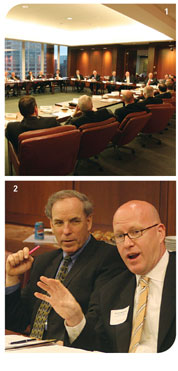
1: KC's leading wealth managers gathered at Commerce Bank to discuss issues of current concern to the industry.
2: Co-Chair Scott Boswell of Commerce Trust Company, right, asked participants to consider how the industry may better educate investors. Jack Cashill observes.
Fred Dunn, with Haas and Wilkerson Insurance, noted that most standard training starts with the financial needs and goals of the client. “I think it needs to go back even more fundamental than that,” said Dunn. “I think the educator needs to start listening to where our clients’ heads are, what their life goals and needs are.”
“Not every investor is the same,” affirmed Dan Dechant with Morgan Stanley. “To get to know someone and educate them takes more than just a five- or ten-minute conversation.” Without that added time, he added, advisors will struggle with those clients who have complex, sophisticated issues to work through.
For Don Hubbs of PrivateBank, the problem is the wealth of information “that simply has overwhelmed almost all of the clients.” He sees product as less important than emotions. He argued that if an advisor can teach his clients to control greed and develop a long-term perspective on the market, “then you can probably have a successful relationship with your client.”
“One of our challenges is helping our clients manage their emotions and expectations,” affirmed Steve Rodewald of Bank Midwest Investments. “They let their emotions get ahead of them. They lose sight of the actual goal in mind.”
Brad Perry of Intrust Bank described a “quagmire of misinformation,” in which clients are immersed and through which advisors have to manage. “The clients have to understand that is, in most cases, noise,” he attested.
Joe Williams, of Commerce Trust Company, made the salient point that the 401K has created a much wider class of investors than ever existed before. “When you were in a pension plan, you never cared how it was invested,” he noted. “Now we are forcing people to make those decisions. We don’t give them as much credit as they deserve. They have control. They take interest. They still make some mistakes.”
“There is a lot out there for people to get confused by,” agreed Tim Hattey, of the Bank of Kansas City. “One of the things that is difficult in education is just continually reinforcing what they have been told and dispelling what may be out there.”
“I think the most important thing we can do for our clients to help them is to demystify this process,” said Matt Wagner of Enterprise Bank & Trust. He observed that there is a tendency among advisors to make matters appear complicated “so clients feel like they need us.” This tendency strikes him, however, as counterproductive.
“When I started in business 30 years ago, they taught financial advisors to be financial advisors,” said Mike Searcy of Searcy Financial Services. “Fifteen years into my practice, I discovered that it is really about the people and not so much about the money.”
Multi-Generational Issues
As Jack Ovel observed, clients have “a plethora of financial products and services” to choose among and access to a great deal of information to help them choose. “At the end of the day,” he added, “what all of us are really providing is advice.” He asked those gathered whether multi-generational issues affect the kind of advice they give.
On the private wealth management side of Robert W. Baird, Bob Rippy noted that he and others use what they call “life mapping.” In the initial meeting there is virtually no talk of product or investments. Instead, they talk about life goals, life plans, and how the clients would like their wealth distributed at the end.
(...continued)